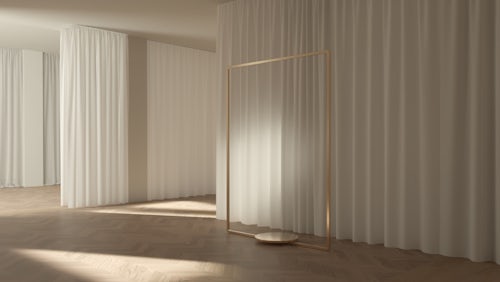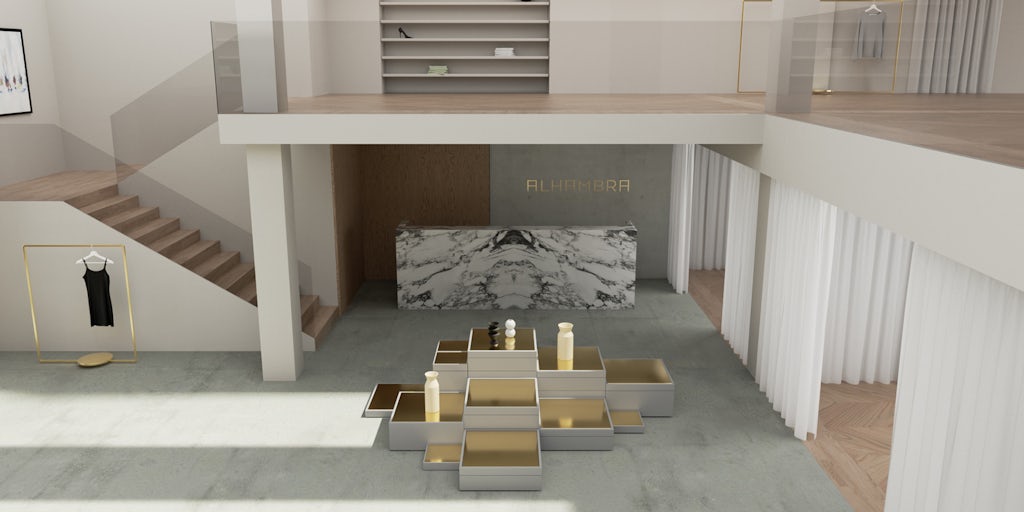Alhambra Berlin’s Concept for Retail in a Post-Covid Era | Sponsored Feature
BERLIN, Germany — Over its near 100-year history, Berlin’s Alhambra building — an architectural landmark located in the city’s luxury shopping mile Kurfürstendamm — has hosted a hotel, ball room, cinema and offices. Now, opening in Spring 2021, it has evolved into a multi-purpose co-retailing space spanning 1,100 sqm across two floors.
Removing the time-consuming and money-intensive exercise of finding the right location and tailored local PR support for a pop-up activation in an unfamiliar market, the creators behind Alhambra Berlin offer a full-service amplification package including a built-in social media strategy, tailored promotion mechanisms, impactful staging, as well as trained sales and event staff.
Brands have the opportunity to experiment with a retail space without the ties of a long-term lease, while also optimising on growing consumer interest in experiential shopping and supporting local businesses. McKinsey’s Covid-19 German Consumer Pulse Survey in June revealed 54 percent of German consumers have tried a new shopping behaviour, with 21 percent citing the support of local businesses a key reason behind the change. A further 20 percent cited supporting local players as a key reason for why they tried a new brand.
The organisers do not take commission on the shop floor and provide promotion and visibility for brands and products in its omnichannel presence, enabling for the customers’ journey to continue beyond the physical space. Alhambra Berlin also offers real-time feedback on consumer behaviour and interaction with products and store fronts, facilitated by state-of-the-art technology and high frequency cameras.

Retail business advisor and concept developer Tatjana Sprick by Jochen Arndt |
Source: Courtesy
Alhambra’s property developer, Wertconcept, enlisted the expertise of retail business advisor Tatjana Sprick. Now, BoF sits down with Sprick to learn more about how the co-retailing space is meeting the evolving preferences of a pandemic-impacted brands, both established and emerging, and the digitally enhanced strategies optimising the shopping experience.
How would you define the concept of co-retailing space at the Alhambra complex?
With Alhambra Berlin, we created a multi-purpose interactive space, where leading and evolving brands, artists and bespoke designers can stage their products and creations. It’s a crossover of shopping and experience, which we aim to achieve by constantly changing our brand range and categories, as well as emphasising the narrative and brand story of each partner. The architectural concept divides the space into different, smaller areas and enables individual staging of the presented brands. Through this, the combination of established names with emerging talents keeps the presentation timely and attractive for a larger community.
In contrast to a classic pop-up store, the risk it carries in finding the right location to attract consumers is minimised through the constant space in a landmark that is known to the local community. An additional benefit is trained staff who will transmit the brand stories and enhance the experience with the products. We also offer an in-house consultancy to adapt the product range to the local audience so brands can trim their portfolios accordingly.
Why are digital amplification packages an important part of your strategy?
Staging brands in an emotional, authentic and unique way is the point of view we want to concentrate on, to achieve that memorable experience. We would work with each brand to see what they really want to get out of their partnership with Alhambra Berlin and then adapt the technical hub to their needs. Each brand has a different focus today and I think it’s important to tailor our amplification package to them.
We are firm believers in the physical shopping experience, but enhancing the digital layer to any business is crucial these days, which is why we are capitalising on this new, common ground and want to enable both dimensions – of experience and purchase – to happen simultaneously online and offline for every brand we feature at Alhambra Berlin.
We would work with each brand to see what they really want to get out of their partnership with Alhambra Berlin and then adapt the technical hub to their needs.
For us, each consumer touch point is a boost because it adds value and purpose to the brand, even if the sales are happening online. We actually aim to push traffic back to the brands’ own websites. We assemble curated editorial content on all our platforms to introduce communities to the products and brands exhibited on the shop floor and then link directly to the brands’ e-commerce on their own website. I envision it will become a space where it’s more about the lifestyle and about finding exceptional products, which a client can purchase and leave with immediately or have delivered to their home. Our aim is to create an experiential journey beyond the physical surface of products and objects.
How does the Alhambra concept reflect today’s retail market?
We previously calculated retail performance and efficiency by how much a square meter can bring in in sales. That’s just not the way we think anymore — we want to have a space that also speaks to the story of a product. So, the value of that particular space is more about its role as a communication platform and showroom.

Alhambra Berlin interior renderings | Source: Courtesy
We want people to come in, take pictures in the space and discover new brands and products, to share their excitement online in their own way throughout the social media channels; meet friends here to hang out in the space and enjoy the atmosphere. We want to turn Alhambra Berlin into a social hub and allow for our guests to engage with their surroundings and interact with the products in the space.
These days, you need to attract the interest of consumers to share your brand story and have them experience the product. If your reach out is only online, you will meet limitations, as you can never engage all senses – but we need to touch, to smell, to taste. Our focus is to communicate and share the story behind each product and brand, designer and maker – to translate their creation into an experience.
What role does in-store technology play in assisting the showcasing brands?
Often, retailers monitor consumer behaviour online, to track the activity of a visitor, but we don’t normally do that in a physical space. At Alhambra Berlin, we are implementing this on a physical level, while still respecting all policies of data protection and privacy. Some department stores count the frequency of people coming in, but we can now go even further and say if it’s a unique visit or even give an age range.
We’re then tracking what consumers do in the shop by using an intelligent software across 19 cameras, which offer a 360 degrees screening of the space. We can see if consumers just focus on one area, or if they are moving from one brand to another. Do they interact with our sales team? Do they try the product on? How long did they spend in one place? Was it more on the left side? On the right? Did they hang out at the bar?
Some department stores count the frequency of people coming in, but we can now go even further and say if it’s a unique visit or even give an age range.
Each partner brand showing with us will get a report on customer behaviour in the space, delivered on a regular basis, so they have real numbers of how and where people are interacting with their product.
How are you upgrading the experiential feature of the store?
The space is large enough to hold hundreds in an audience but now, under the current circumstances, we can create small intimate event formats where a brand can really interact with the audience. We have a huge hall with 6-metre high ceilings, where we can host any kind of presentation, an incredible sound system to serve anything from a conference to a party or sound installation. Additionally, there is a video projection area where we can screen videos on a 5×4 metre cinema wall to help communicate any brand stories, show movies, live-stream fashion shows or summits, integrating the historical role of the building too.
An essential experiential feature is our visual merchandising and window activities — all our fixtures are made to be easily moved and exchanged, so nothing in the shop is static, which allows the space to rapidly transform from a fashion retail area to an exhibition venue or tech event in just hours. We started activating our window front 3 months ago, by showing the works of local designers and curators to engage with our community before the opening. We have seen pedestrians stop and interact with the windows — even buy products off the display.
What is your long-term strategic vision to better serve Alhambra consumers?
Our long-term vision is to seamlessly merge the still somewhat disconnected worlds of physical retail and brand staging with memorable product experience. We want to turn the space into a source of product and design innovation in the heart of Berlin, to speak to a community of consumers who want to interact and engage with a brand before purchase.
Over the next year, we will build in more capabilities to even further customise the experience level on the floor and through an app. Our communication tools will all be fitted to what our community and visitors want to look at and know about, so they can fully plan and customise a visit to Alhambra Berlin and tailor the visit upon their own preferences. They will be able to set up a personal shopping session or meet up with friends, pre-order items and book special services. All these elements come piece-by-piece to make the experience more interesting.
This is a sponsored feature paid for by Wertconcept as part of a BoF partnership.

